Natural herbs create vibrant, long-lasting colors in your handcrafted soaps while delivering therapeutic benefits that synthetic dyes can't match. You'll find that herbs like calendula, spirulina, and turmeric infuse soaps with stunning hues and skin-nourishing properties. When you use the cold process method and proper infusion techniques, these botanical ingredients maintain their vibrancy throughout curing. Whether you're crafting simple bars or complex designs, understanding herb selection and preparation reveals endless creative possibilities.
Natural Herbal Colorants in Soap Making
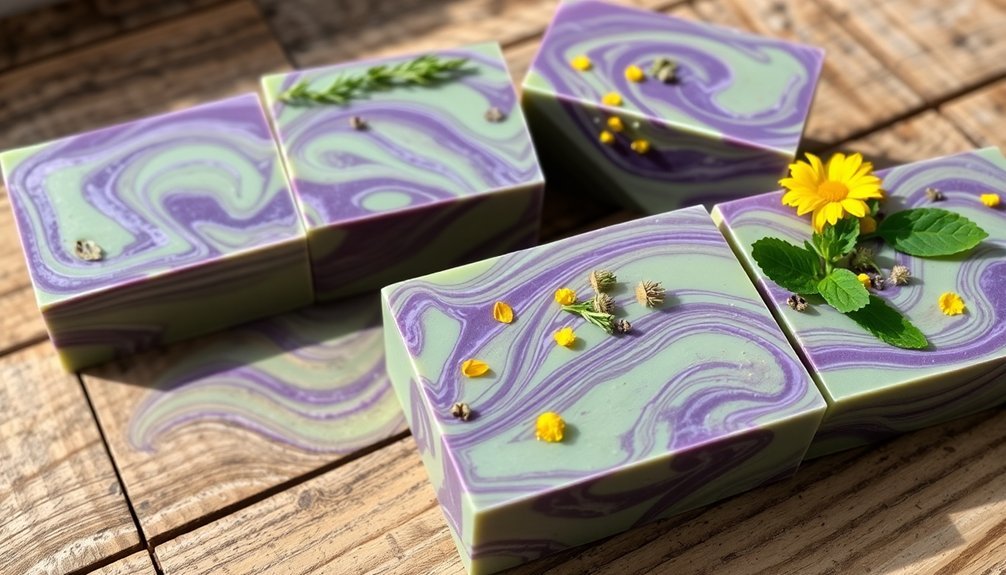
While synthetic dyes dominate commercial soap production, natural herbal colorants offer a beautiful and sustainable alternative for handcrafted soaps.
Natural colorants from herbs bring beauty and sustainability to handmade soaps, offering an earth-friendly alternative to artificial dyes in commercial products.
You'll discover that ingredients like spirulina and turmeric create vibrant color profiles while maintaining your commitment to eco-friendly practices.
When you're crafting soaps, you can harness the power of calendula for its golden hues and skin-soothing beneficial properties.
Nettle infusions don't just contribute rich green tones – they'll also enhance your soap's impact on skin health through their vitamin and mineral content.
For added visual appeal, try sprinkling dried cornflowers on top of your handcrafted soaps rather than mixing them into the batter, where they might yellow.
Essential Properties of Soap-Making Herbs
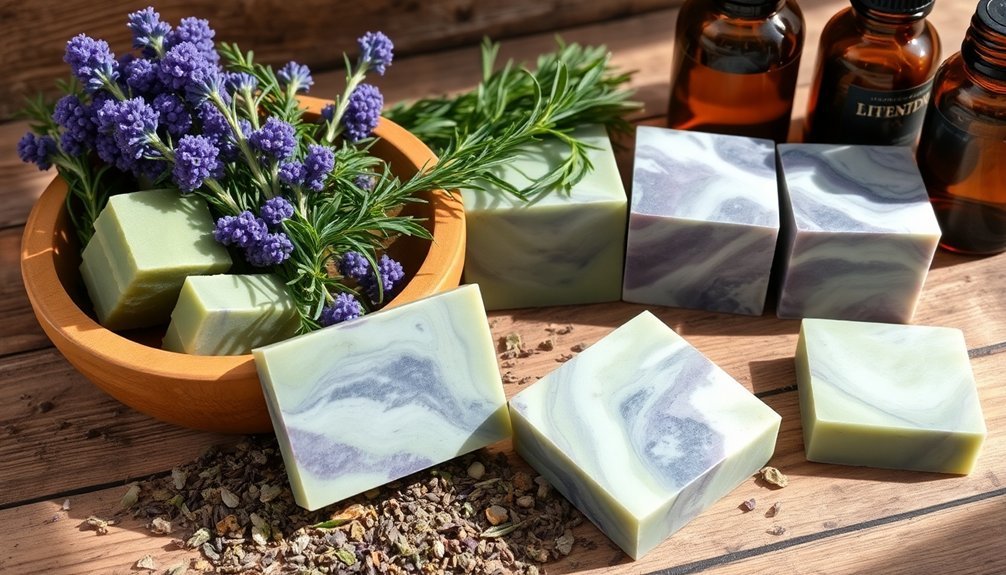
Beyond their natural coloring abilities, herbs bring remarkable therapeutic qualities to handcrafted soaps. You'll find that herbs like chamomile and nettle offer powerful anti-inflammatory properties that soothe irritated skin, while yarrow provides astringent benefits that can help heal various skin conditions.
When you're crafting soaps, you can incorporate dried herbs such as calendula and cornflowers for visual appeal, while their essential oils deliver therapeutic benefits to your final product.
Herbs like peppermint and lemon balm don't just contribute invigorating fragrances – they enhance the overall bathing experience with their natural healing properties. By choosing these natural ingredients, you're creating more than just soap; you're developing a luxurious skincare product that combines aesthetic beauty with genuine therapeutic value.
The result is a handcrafted soap that's both visually stunning and deeply beneficial.
Preserving Herbal Vibrancy Through Cold Process
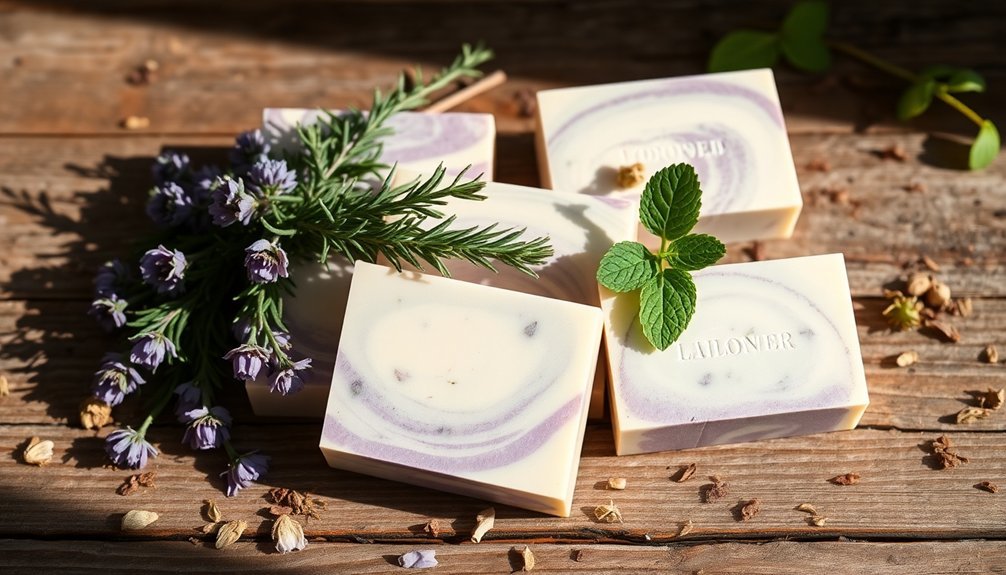
To preserve the vibrant colors and therapeutic properties of herbs in handcrafted soaps, the cold process method stands out as an ideal technique. You'll find that this method's lower temperatures protect herbs from discoloration, allowing their natural hues to shine through your finished product.
When you're crafting soap, infusing oils with herbs before the saponification process helps extract their vibrant colors and therapeutic benefits. You'll see particularly stunning results with calendula, which maintains its bright yellow and orange tones throughout the curing process.
Soap makers can enhance these visual effects by using finely pulsed dried herbs, creating an appealing speckled appearance that lasts. The slow, controlled nature of cold process soap-making guarantees a stable chemical reaction, helping your herbal additions maintain their integrity and vibrancy from the first pour to the final cure.
Optimal Herb Selection and Preparation Methods
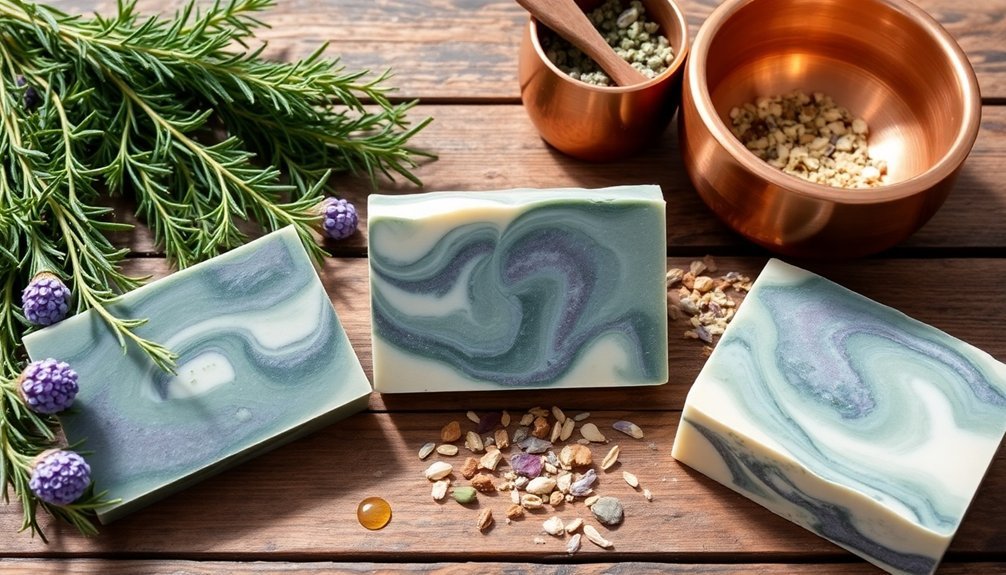
When selecting herbs for your handcrafted soaps, you'll find that dried varieties like calendula and chamomile maintain their colors better during saponification, while fresh herbs require special handling to prevent spoilage.
You can maximize the benefits of both fresh and dried herbs by infusing them into oils or lye water before soap making, using 1/2 to 1 teaspoon per pound of soap.
If you're working with fresh herbs, puree them or cut them into small pieces to guarantee even distribution and prevent discoloration, whereas dried flowers can be used as decorative elements after the curing process.
Fresh Vs Dried Herbs
Although both fresh and dried herbs can enhance handcrafted soaps, dried herbs typically offer superior results and fewer complications. When you're crafting soaps, dried herbs provide better stability and longevity while minimizing spoilage risk.
You'll find that using 1/2 to 1 teaspoon of finely ground dried herbs per pound of soap creates an attractive speckled appearance.
To maximize therapeutic properties and vibrant colors, consider infusing dried herbs into oils before incorporating them into your soap mixture.
While fresh herbs can add unique textures, they often introduce unwanted moisture and may lead to browning or mold. If you must use fresh herbs, puree them finely and use sparingly.
You'll achieve more consistent results with dried herbs, ensuring your handcrafted soaps maintain their visual appeal and quality over time.
Herb Infusion Techniques
Selecting the right herbs and preparation methods stands at the core of successful soap infusion. Proper infusion techniques will help you extract maximum therapeutic benefits and vibrant color from your culinary herbs.
You'll want to focus on methods that preserve the natural properties while ensuring ideal integration into your soap making process.
- Mix dried herbs into your soaping oils using a 1/2 to 1 teaspoon ratio per pound of soap.
- Steep herbs in low-temperature oil to extract their beneficial properties.
- Infuse dried herbs in lye water for enhanced color transfer.
- Puree fresh herbs finely to prevent texture issues.
When infusing dried herbs, remember to maintain consistent temperatures and monitor steeping times.
Chamomile, calendula, and peppermint work exceptionally well, offering both aesthetic appeal and skin-nourishing properties to your finished soap.
Blending Techniques for Lasting Herbal Colors
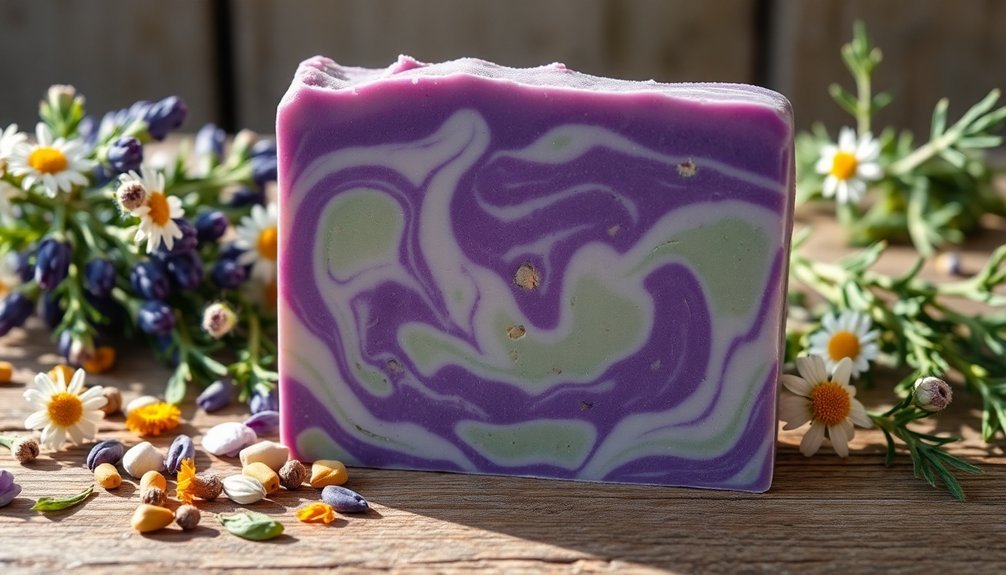
You'll achieve the most vivid and enduring colors in your herbal soaps by infusing dried botanicals in your base oils or lye water before mixing.
If you're working with fresh herbs, puree them thoroughly and add them after trace to minimize browning, though you should expect some color changes over time.
To maintain the brightest natural hues, store your dried herbs in airtight containers away from light and moisture before use, and consider adding them as a final decorative touch after the soap has cured.
Herb Infusion Methods
When creating naturally colored soaps, mastering herb infusion methods will greatly impact your final product's vibrancy and longevity. You'll find that different techniques offer unique ways to extract natural colorants and medicinal properties from your chosen herbs.
- Steep dried herbs in oils or lye water to extract their beneficial compounds and create vibrant soap formulations.
- Use finely ground herbs for delicate speckled effects, while whole herbs add dramatic visual interest.
- Puree fresh herbs into smaller pieces to prevent bleeding and guarantee even distribution.
- Time your infusions carefully – add herbs after the soap has cooled slightly to prevent browning.
Remember that calendula-infused oils create lasting golden hues, making them ideal for natural colorants.
Whether you're working with dried or fresh herbs, proper infusion timing guarantees your soap maintains its intended color profile.
Preventing Color Fade
Natural soap colors can fade considerably without proper herbal blending techniques. To prevent color fade, you'll want to use dried herbs instead of fresh ones, as they maintain their hues better during saponification.
Start by infusing your dried herbs into oils before mixing your soap batter for maximum vibrant color extraction.
Color-stabilizing herbs like calendula are your best allies for maintaining visual appeal, as they'll keep their golden tones longer.
You'll achieve better results by pulsing your herbs into smaller pieces rather than using whole leaves or petals. This creates an attractive speckled effect while reducing moisture that can lead to browning.
Don't forget proper curing techniques – store your soaps in a cool, dry space and avoid insulating them right after adding herbal decorations to preserve those beautiful colors.
Therapeutic Benefits of Herbal Soap Infusions
The therapeutic benefits of herbal soap infusions extend far beyond their pleasant aromas and visual appeal.
These customized formulations combine nature's healing power with vibrant color, offering you a thorough skincare solution. You'll find that herbal soap infusions deliver multiple antioxidant properties while addressing specific skin concerns.
- Chamomile and lavender provide calming properties that soothe irritated skin and promote relaxation during your daily cleansing routine.
- Calendula and yarrow infusions enhance skin health while adding natural color to your soap.
- Nettle and goldenseal deliver protective antioxidants that shield your skin from environmental damage.
- Peppermint and lemon balm create an invigorating experience that's perfect for morning use.
Achieving Color Stability With Dried Herbs
Successfully achieving color stability in herbal soaps requires careful attention to both herb selection and preparation methods.
You'll find that dried herbs can be infused into soaping oils or water to create vibrant, lasting colors in your handcrafted soaps. When you're working with dried flowers like calendula, you'll get better color stability through infusions rather than direct incorporation, which can lead to browning.
For the best visual aesthetics, use 1/2 to 1 teaspoon of dried herbs per pound of soap. You can control the appearance by choosing between whole dried herbs for distinct speckles or finely pulsed herbs for a more uniform look.
Remember to properly dry and store your herbs before use – this prevents moisture absorption that could compromise color stability during the curing process.
Advanced Herb Layering and Design Methods
Creating visually stunning soaps requires mastery of advanced herb layering techniques that combine both artistry and science.
You'll discover that natural soap making becomes an intricate dance of timing and precision as you infuse oils with carefully selected herbs to achieve vibrant colors and therapeutic properties.
Your advanced herb layering success depends on:
Success in advanced herb layering emerges from precise timing, expert infusion control, and strategic placement of therapeutic botanicals throughout your soap.
- Strategically incorporating herbs during the cold process to preserve their active compounds
- Controlling infusion strength to achieve desired color intensity and skin benefits
- Timing the addition of finely pulsed herbs to create distinct visual patterns
- Layering different herb combinations to produce multiple therapeutic zones
You can experiment with various herbs like calendula for orange hues or chamomile for golden tints, pressing larger dried herbs on top for a finishing touch that's both beautiful and beneficial.
Frequently Asked Questions
What Makes Homemade Soap Last Longer?
You'll get longer-lasting homemade soap by using quality oils, allowing proper curing time, adding natural exfoliants, and storing in cool, dry places. The glycerin produced during saponification helps maintain the bar's integrity.
What Herbs Are Best for Soap?
You'll find calendula, chamomile, and lavender are excellent soap-making herbs. For therapeutic benefits, try rosemary and peppermint. If you're targeting sensitive skin, yarrow and nettle work well. Each adds unique natural properties.
What Are the Benefits of Herbal Soap?
You'll get natural antioxidants and anti-inflammatory benefits from herbal soaps. They'll soothe your skin, reduce irritation, and provide therapeutic properties. Plus, you'll enjoy invigorating fragrances while nourishing your skin with natural vitamins.
How Long Does Herbal Soap Last?
Your herbal soap will last 1-2 years when you store it properly in a cool, dry place. If you've cured it for 4-6 weeks and keep it away from sunlight, it'll maintain its qualities longer.
In Summary
Whether you're just starting out or you're an experienced soap maker, you'll find that herbs offer an endless palette of natural colors and therapeutic benefits for your creations. By selecting the right herbs, preparing them properly, and using proven infusion techniques, you'll create vibrant, long-lasting soaps that reflect nature's beauty. Keep experimenting with different combinations and layering methods to develop your unique herbal soap signature.

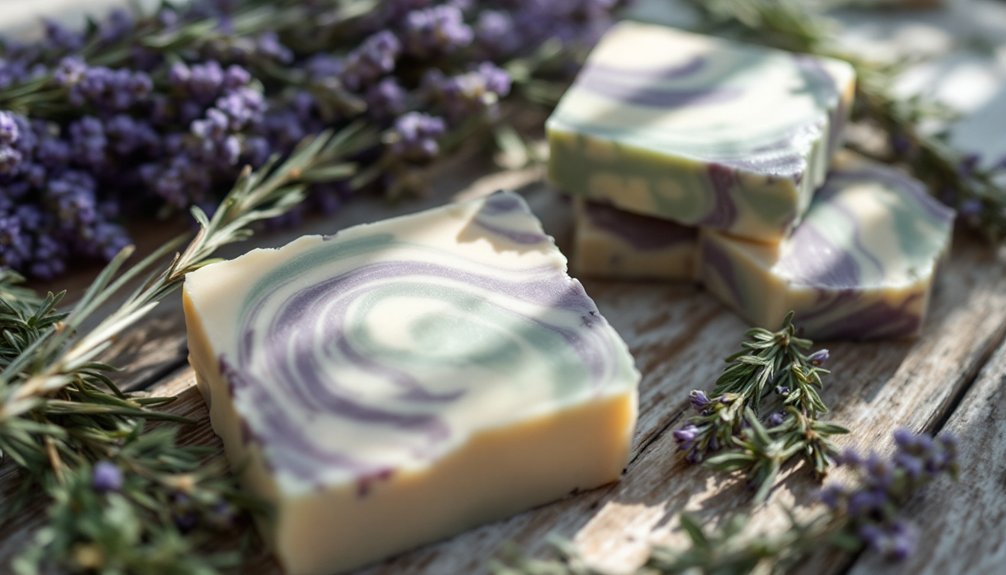
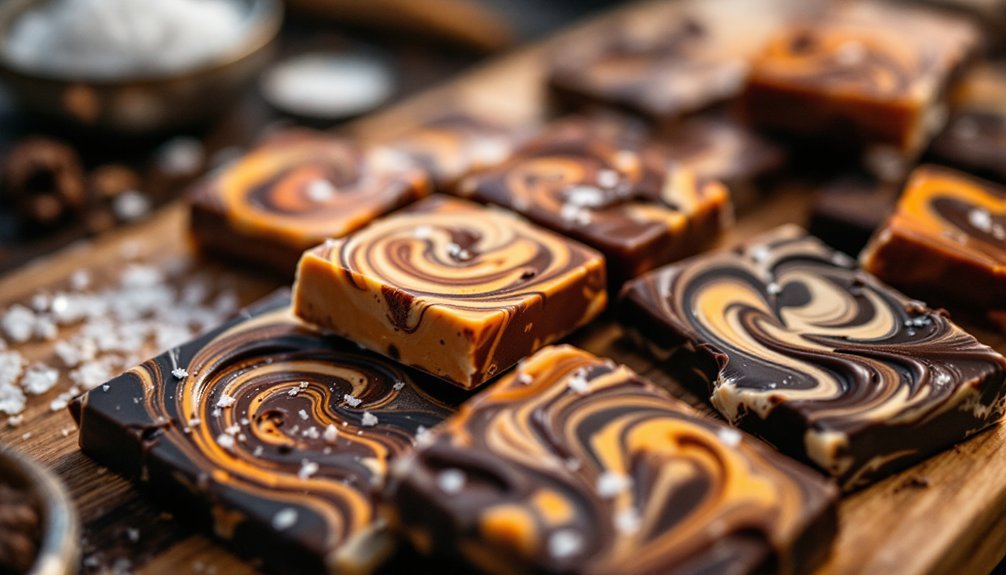
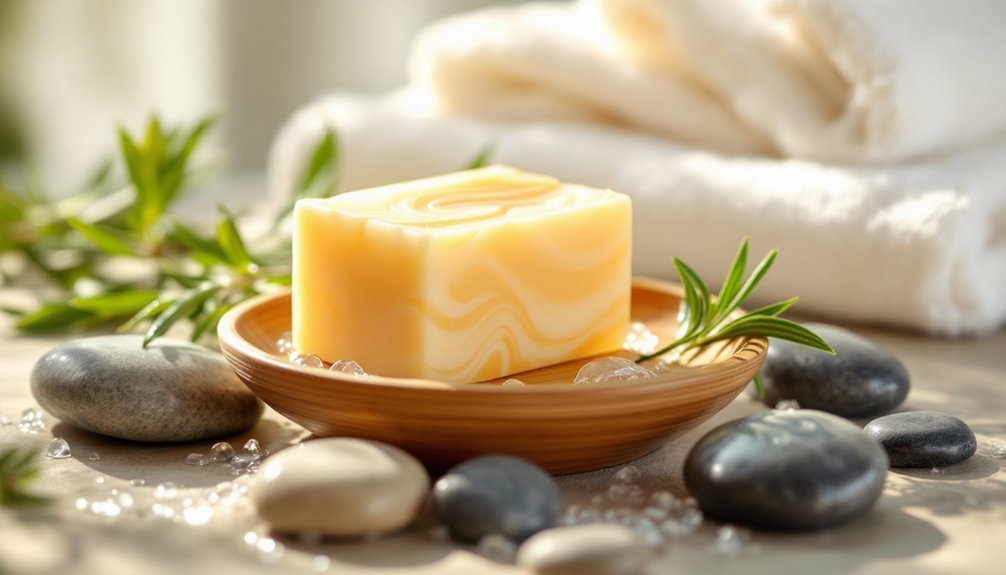
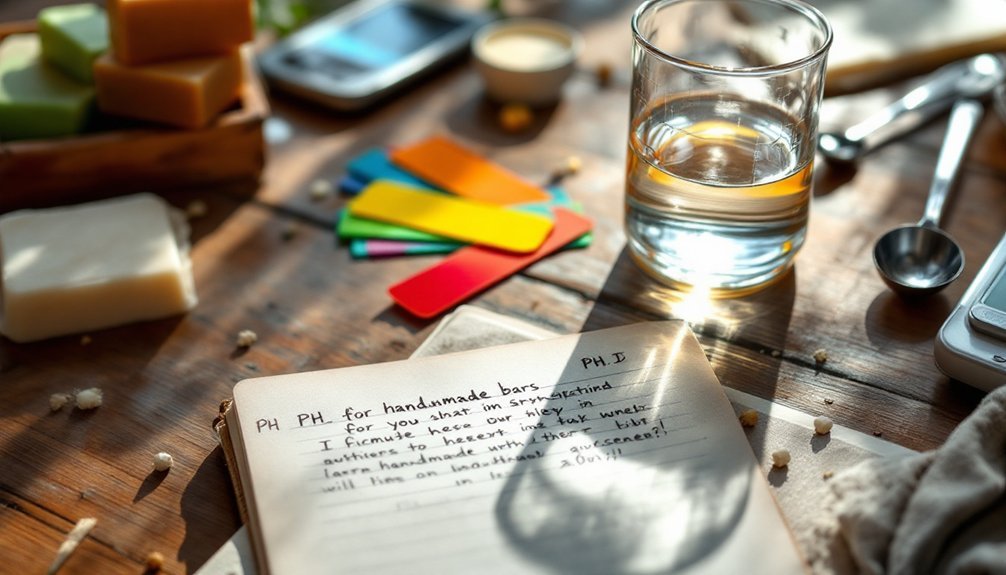
Leave a Reply